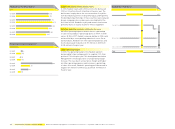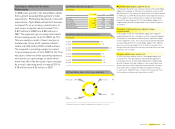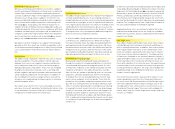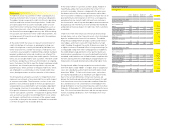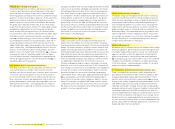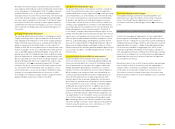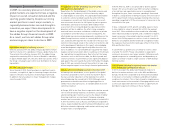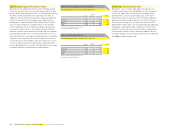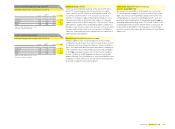Reebok 2008 Annual Report Download - page 117
Download and view the complete annual report
Please find page 117 of the 2008 Reebok annual report below. You can navigate through the pages in the report by either clicking on the pages listed below, or by using the keyword search tool below to find specific information within the annual report.
adidas Group Annual Report 2008 113
Risks from loss of key event or promotion partnerships
Event and promotion partnerships play an important role
in building brand image and generating sales of licensed
products. The adidas Group faces the risk of either losing
key partnerships or having to accept unfavourable terms due
to inten si fi ed competition for attractive contracts. During
2008, for example, the French Football Federation and adidas
decided not to renew their promotion partnership.
To mitigate these inherent risks, we regularly seek to extend
our most important partnership agreements before contract
expiry. For example, in 2008 adidas extended contracts with
two of the world’s most recognised teams: AC Milan and the All
Blacks see adidas Strategy, p. 048.
We also regularly include change-of-control clauses as well
as non-cash compensation components in contracts to avoid
the risk that negotiations are reduced solely to price. In addi-
tion, we follow a strategy of broadening the Group’s portfolio of
premium partnerships in order to reduce our reliance on single
affi liations.
Due to increasing competition for promotion partners wit-
nessed over recent years, we continue to believe there is a
medium likelihood
of losing important individual promotion
contracts. Never
theless, given the maturity of our most impor-
tant contracts, we assess the potential fi nancial impact of this
risk to be low in the medium term.
Product design and development risks
Innovative and attractive products generate strong sales and –
more importantly – create a halo effect for other products. The
speed with which new product technologies and fresh designs
are brought to market is decisive for maintaining competitive
advantage. In 2008, all brands generated the majority of their
sales with products which had been brought to market over
the last 12 to 18 months see Research and Development, p. 074.
If the adidas Group failed to maintain a strong pipeline of
new innovative products over a sustained period of time, we
would risk a signifi cant sales decline. We continue to invest in
increasing our innovational and design strength. To ensure we
can quickly adapt to changing consumer preferences, we focus
on streamlining research and development processes to speed
up the time to market.
We continue to assess the occurrence probability of this risk,
which could potentially have a signifi cant fi nancial impact, as
low.
Personnel risks
The adidas Group’s future success is highly dependent on our
employees and their talents. Loss of key personnel in strategic
positions, to competitors or others, is therefore a signifi cant
risk we face. In addition, as labour markets become increas-
ingly competitive, we also face the risk of being unable to
identify, recruit and retain the most talented people that best
meet the specifi c needs of our Group. To reduce this risk and
enable our employees to make use of their full potential, we
strongly engage in developing a motivating working environ-
ment. Our goal is to make the adidas Group the “Employer of
Choice” within our industry. This is supplemented by offering
attractive reward and incentive schemes as well as long-term
career opportunities and planning see Employees, p. 070.
Our overall assessment of personnel risks remains unchanged
compared to the prior year. Although we have grown our own-
retail activities (where employee turnover is higher than the
Group average) and increased our employee base in emerging
markets (where higher levels of wage infl ation increase the
volatility of the employment market), the current economic
environment is likely to reduce volatility of the overall employ-
ment market. Therefore, we continue to regard the occurrence
likelihood of these risks as low. Should these risks materialise,
they could have a medium fi nancial impact on our Group.
Risks from non-compliance
We face the risk that our employees breach rules and stan-
dards that guide appropriate and responsible business behav-
iour. In order to successfully manage this risk, the Group Policy
Manual was launched at the end of 2006 to provide the frame-
work for basic work procedures and processes. It also includes
a Code of Conduct which stipulates that every employee shall
act ethically in compliance with the laws and regulations of
the legal systems where they conduct Group business. During
2008, all of our employees were trained on a Code of Conduct
e-learning tool as part of our Global Compliance Programme.
All new employees are also trained on this tool see Corporate
Governance Report, p. 026. Participation is mandatory for all
employees.
We continue to regard the likelihood of grave misconduct as
low. Should they materialise, these risks could have a medium
fi nancial impact on the Group.
IT risks
Most of our business processes rely on IT systems, such as
product marketing, order management, warehouse manage-
ment, invoice processing, customer support or fi nance report-
ing. A Group-wide breakdown of IT systems or a signifi cant
loss of data could result in considerable disruptions to our
business. Insuffi cient project management could delay the
execution of projects critical to the Group or make them more
expensive than planned. To mitigate system default risk, we
review our IT policy on a regular basis and engage in pro-
active maintenance and business continuity planning. We also
ensure security of data by restricting user access and requiring
password changes every 90 days on our most critical systems.
We perform scheduled backups several times a day and one
full backup daily, alternating between two different data centre
locations. In addition, for the central enterprise resource plan-
ning system, our contingency solution allows us to quickly
switch to a remote site if necessary – without any data loss.
System security and reliability are reviewed and tested inter-
nally and via external audits on a regular basis. Our target
availability of 99.7% for major IT applications was exceeded in
2008. IT project risks are further mitigated by implementing a
proven project methodology for all IT projects and by perform-
ing regular risk reviews for all major projects.
We believe the risk of a major IT default continues to be low.
Such a default, however, would result in a signifi cant potential
fi nancial impact.



